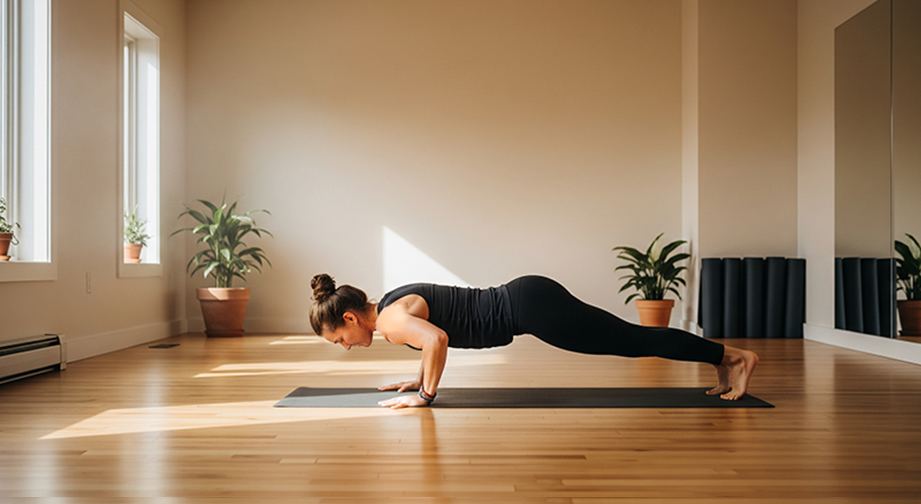Chaturanga Dandasana: Four-Limbed Staff Low Plank (Yoga Asana Guide)
Introduction
Chaturanga Dandasana, also known as the Four-Limbed Staff Pose or Low Plank, is a foundational yoga posture that builds core strength, stabilizes the body, and increases focus. In Sanskrit, "Chatur" means four, "Anga" means limb, and "Danda" refers to a staff — so this pose literally means the four-limbed staff pose.
Essence: Energizing & Strengthening
If you’ve ever wanted a move that boosts your whole-body strength while connecting mind and breath, Chaturanga Dandasana is your best friend — and yes, if classic push-ups feel tough, you’re in the right place!
Step-by-Step Guide to Chaturanga Dandasana

- Start in Plank Pose: Shoulders over wrists, body in a straight line, feet hip-width apart.
- Inhale: Firm your thighs and draw your belly in, activating your core.
- Exhale: Slowly lower your body by bending elbows straight back, hugging them close to your ribs.
Keep your body in a straight line from head to heels—don’t let your hips drop or chest touch the floor.
- Stop when your elbows form a 90-degree angle (upper arms parallel to the floor).
- Hold: Breathe steadily (gentle Ujjayi breath if comfortable). Hold for 10–30 seconds, or 3–5 breaths.
- To release: On an exhale, lower down to the mat for Cobra or upward-facing dog, or push back to Downward-Facing Dog.
- Beginner Modification: Drop knees to the floor and lower torso as above for extra support.
- Advanced: Hold longer, or transition smoothly to upward-facing dog without touching the floor.
Repeat for 2–3 rounds, resting in Child's Pose as needed.
Alignment & Safety Tips
- Key Alignment: Keep shoulders in line with elbows (not dropping below). Elbows hug the ribcage, body stays straight.
- Core engaged: Avoid sagging your hips or lifting the buttocks too high.
- Common Mistakes:
• Dipping the chest before the torso—keep a single, firm line.
• Hands too far forward—wrists should be directly under the elbows.
• Flaring elbows out—keep them close to ribs for joint safety.
- Safety: Avoid this pose if you are pregnant, have wrist/shoulder injuries, or recent abdominal surgery. When in doubt, consult your doctor or a certified yoga instructor.
Benefits of Chaturanga Dandasana
Physical Benefits
- Strengthens arms, wrists, shoulders, chest, and core
- Builds stability and improves posture
- Prepares body for arm balances and advanced poses
Mental Benefits
- Invites focus and brings awareness to the present moment
- Promotes a sense of discipline and perseverance
- Calms the mind through steady, mindful breathing
Energy / Chakra Connection
- Activates the Manipura Chakra (solar plexus), boosting self-confidence and inner power
Contraindications
- Pregnancy
- Recent or chronic injuries to wrists, elbows, or shoulders
- Carpal tunnel syndrome
- Abdominal surgery or hernia
Safer alternatives: Plank Pose (Kumbhakasana), Knees-Chest-Chin Pose (Ashtanga Namaskara), or practice on the knees with props.
Beginner’s Tips & Variations
- Props: Place a yoga block under your chest for gentle support or use a strap around your upper arms to maintain alignment.
- Gentle Variation: Drop your knees and practice “half” chaturanga, or do the movement against a wall.
- Advanced: Lift one leg for a challenge or practice slow, controlled lowers and transitions to upward dog.
How to Include Chaturanga Dandasana in Your Yoga Flow
- Best as part of a main practice or flowing sequence like Sun Salutation (Surya Namaskar).
- Pairs well with:
- Plank Pose (Kumbhakasana) – as a starting point
- Upward-Facing Dog (Urdhva Mukha Svanasana) – as a follow-up transition
- Downward-Facing Dog (Adho Mukha Svanasana)
Mind-Body Connection
As you practice Chaturanga Dandasana, bring your attention inward. Notice your breath, the sensation of your muscles working, and the feeling of grounding through your palms and toes. This asana is a moving meditation, teaching both mental clarity and confidence.
Spiritually, Chaturanga Dandasana awakens the solar plexus chakra (Manipura), empowering transformation, willpower, and your inner strength.
Summary Box
Asana Name: Four-Limbed Staff Low Plank (Chaturanga Dandasana)
Level: Intermediate (With modifications, suitable for beginners)
Focus Areas: Core, Shoulders, Arms, Chest
Duration: 10–30 seconds / 2–3 rounds
Best Time to Practice: Morning or as part of a flow
FAQs – Chaturanga Dandasana
Is Chaturanga Dandasana safe for beginners?
Yes, with modifications! Start with knees down or use props. Focus on alignment over depth or duration.
Can Chaturanga Dandasana help with arm strength?
Absolutely – regular practice strengthens arms, wrists, and shoulders.
What yoga poses prepare you for Chaturanga?
Plank, Knees-Chest-Chin, and Cobra are great preparatory poses.
I have wrist pain – what should I do?
Avoid weight-bearing on wrists and try alternatives like Wall Chaturanga or Plank with knees down. Consult a teacher if unsure.